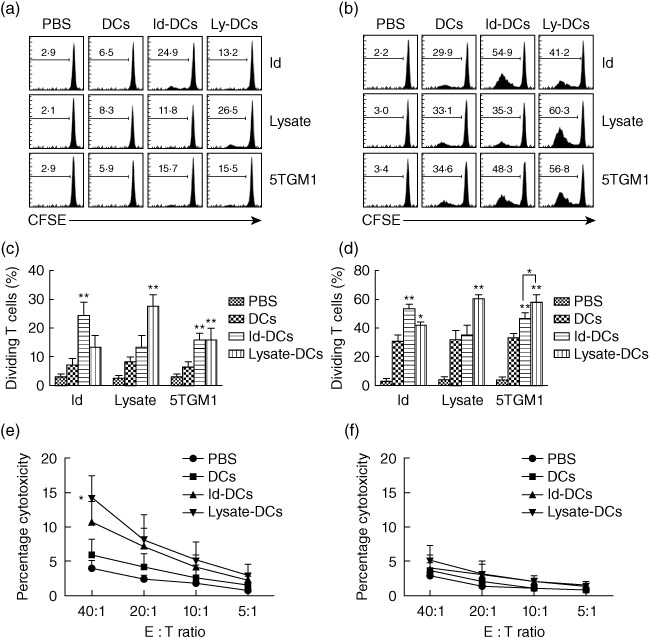Fig. 5.

Proliferative and cytotoxic activity of T cells in mice receiving dendritic cell (DC) vaccines. 5,6-Carboxyfluorescein diacetate succinimidyl ester (CFSE) dilution assay showing the percentages of proliferating CD4+ (a) and CD8+ (b) T cells in splenocytes of mice after restimulation in vitro with idiotype (Id) protein (Id), tumour lysate (lysate) or irradiated 5TGM1 myeloma cells (5TGM1) for 5 days. Values in each histogram represent the percentages of dividing CD4+ or CD8+ T cells. Summarized data for percentages of proliferating CD4+ (c) or CD8+ (d) T cells from three different experiments are shown. Also shown is cytotoxicity activity against 5TGM1 myeloma cells (e) or B16 melanoma cells (f) of splenocytes of mice after restimulation with irradiated 5TGM1 myeloma cells for 7 days. In these studies, tumour-free mice (three per group) were vaccinated with three weekly subcutaneous injections of phosphate-buffered saline (PBS), unpulsed DCs (DCs), Id-KLH-pulsed DC vaccine (Id-DCs) or tumour lysate-KLH-pulsed DC vaccine (lysate-DCs). Splenocytes were isolated, pooled, prelabelled with 5 µM CFSE, restimulated with Id protein, tumour lysate or irradiated 5TGM1 cells for 5 days, and measured for CSFE dilution. Splenocytes were isolated, pooled and restimulated with irradiated 5TGM1 myeloma cells for 7 days and the percentage of cytotoxicity was measured by 51Cr-release assay. Representative results from one of three experiments are shown. The error bars represent standard deviations of three independent experiments. *P < 0·05; **P < 0·01, compared with PBS or unpulsed DC controls.
